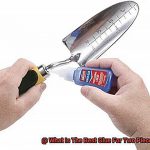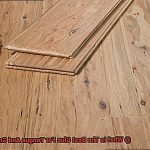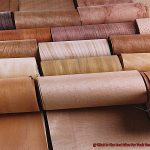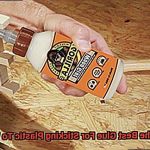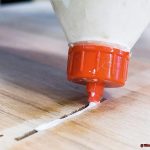Whether it’s a pesky tear, a rebellious loose seam, or a complete upholstery overhaul, finding the perfect glue for vinyl chair repair is absolutely crucial to bring them back to their former glory. But with an overwhelming number of options flooding the market, choosing the right one can feel like navigating a treacherous sea of adhesives.
Fear not. That’s where we swoop in to save the day.
Contents
- 1 What is Vinyl Chair Repair?
- 2 Factors to Consider when Choosing the Best Glue for Vinyl Chair Repair
- 3 Vinyl Cement Adhesives
- 4 Contact Adhesives
- 5 Choosing a Water-Resistant or Waterproof Glue
- 6 Choosing a Glue That Dries Clear or Matches the Color of the Vinyl Material
- 7 Following Instructions and Application Techniques for Optimal Results
- 8 Conclusion
In this blog post, we’ll dive headfirst into the captivating realm of vinyl chair repair glue, exploring all its nooks and crannies. We’ll uncover different types of glues, weigh their pros and cons, and ultimately unveil the top contenders for the coveted title of best glue for your unique repair needs.
So grab yourself a steaming cup of coffee, settle into your comfiest chair (hopefully not in dire need of repair), and prepare to embark on an exhilarating journey through the world of vinyl chair restoration.
What is Vinyl Chair Repair?
Over time, these chairs can suffer from wear and tear, leaving behind unsightly tears, rips, or loose seams. The good news is that vinyl chair repair offers a cost-effective solution to restore the beauty and functionality of your furniture. In this blog post, we will explore the process of vinyl chair repair, the different methods and techniques involved, and the importance of choosing the right glue for a successful repair.
Identifying and addressing damages:
Vinyl chair repair begins by identifying and addressing various types of damages such as tears, rips, punctures, or loose seams. These damages can occur due to regular use, accidental spills, sharp objects, or even pets scratching the surface of the chair. By repairing these damages promptly, you can prevent further deterioration and extend the lifespan of your vinyl chairs.
Methods and techniques:
- Vinyl repair kits: For minor tears or punctures, using a vinyl repair kit can be an effective solution. These kits typically include adhesive patches or liquid vinyl repair compounds that can be used to fill in the damaged area. They are easy to use and often come with detailed instructions for DIY repairs.
- Professional assistance: More significant damages may require professional assistance. Upholsterers or furniture repair specialists have the expertise and access to specialized tools and materials to handle complex vinyl chair repairs. They can effectively repair large tears or extensive seam separations, ensuring a seamless restoration of your chair.
Choosing the right glue:
When it comes to repairing vinyl chairs, choosing the right glue is crucial for a long-lasting and effective repair. Consider the following factors when selecting a glue:
- Specific requirements: Assess the specific requirements of the repair. Some glues are formulated for general use, while others are specifically designed for vinyl repairs.
- Exposure to outdoor conditions or moisture: If the chair will be exposed to moisture, it is important to choose a glue that is water-resistant or waterproof.
- Desired aesthetics: Select a glue that dries clear or matches the color of the vinyl material for an aesthetically pleasing repair.
Factors to Consider when Choosing the Best Glue for Vinyl Chair Repair
Vinyl chairs are loved for their durability and ease of maintenance, but over time they can develop tears, rips, or loose seams. To restore their functionality and appearance, it’s crucial to choose the right glue. In this comprehensive guide, we will explore the key factors to consider when selecting the best glue for vinyl chair repair.
Adhesive Strength:
Look for glues specifically designed for vinyl or upholstery repairs. These glues offer superior bonding properties, creating a strong bond that can withstand the stress and movement experienced by vinyl chairs.
Flexibility:
Choose a flexible adhesive that can adhere to the vinyl surface without cracking or becoming brittle over time. This ensures that the repaired area can move and flex without compromising the bond.
Water Resistance:
Select a water-resistant glue to protect against spills and moisture. Water-resistant adhesives are more durable in humid or wet environments and prevent the growth of mold or mildew.
Drying Time:
Consider the drying time of the glue, especially if you need to complete the repair quickly. Some glues dry quickly, allowing you to use the chair sooner, but be sure to follow curing time instructions for a proper bond.
Ease of Application:
Look for glues with applicators or nozzles that make it easy to apply the adhesive precisely. Quick-grab properties are desirable, allowing you to reposition the vinyl during bonding if needed.
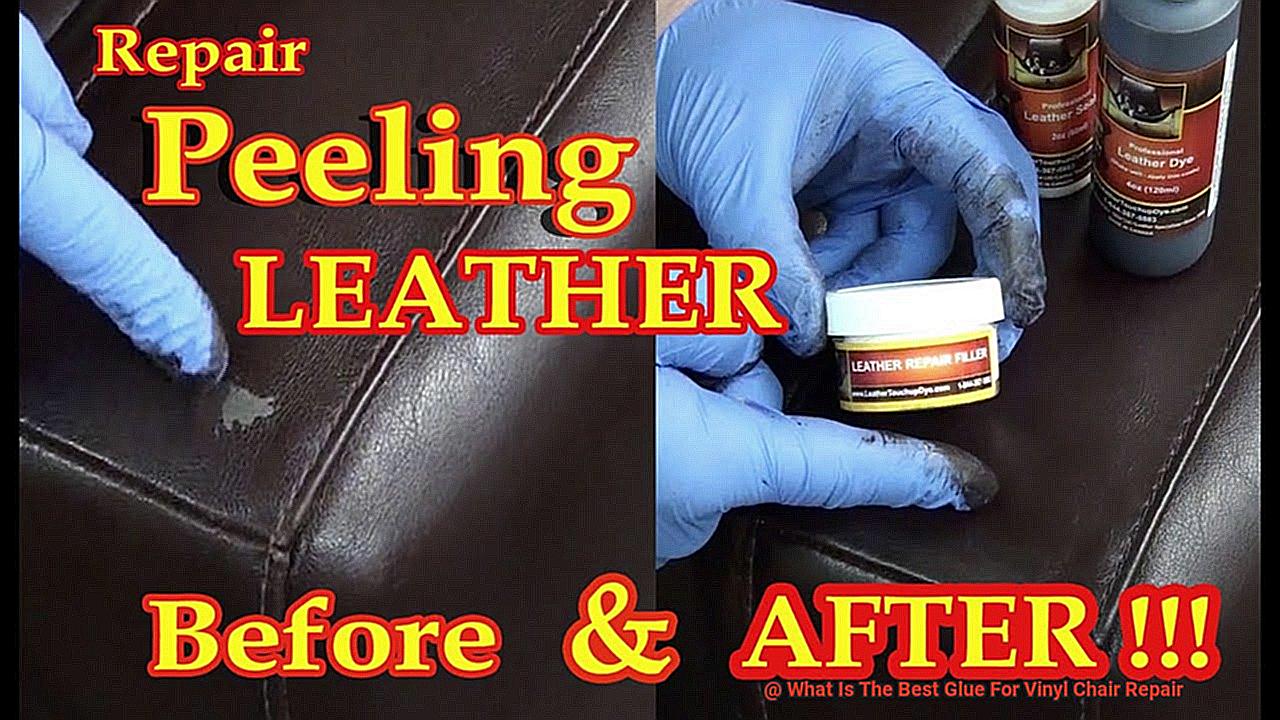
Color Matching:
Consider the color of the glue and how well it matches your vinyl chair. Clear glues are popular as they maintain the chair’s original appearance, but choose a color-matching glue if aesthetics are crucial.
Toxicity:
Opt for glues with low volatile organic compounds (VOCs) and minimal odors, especially in poorly ventilated areas or for individuals with sensitivities. This ensures a safe working environment and minimizes any potential health risks.
Durability:
Check for glues specifically formulated for vinyl repairs, ensuring they provide a long-lasting bond that can withstand regular use without weakening or deteriorating.
Vinyl Cement Adhesives
Vinyl cement adhesives are the ultimate saviors for your worn-out vinyl chairs. These specialized adhesives are designed specifically for bonding vinyl materials, making them the go-to choice for chair repairs. But what sets them apart from other adhesives? Let’s explore the key benefits of using vinyl cement adhesives in chair repair.
First and foremost, vinyl cement adhesives create a permanent bond that is hard to break. Once applied and dried, these adhesives form a strong connection that ensures your chair repair remains intact and functional. Say goodbye to loose seams and hello to a chair that’s as good as new.
Flexibility is another remarkable feature of vinyl cement adhesives. Vinyl materials, especially in chairs, are prone to flexing and bending. These adhesives are formulated to match the flexibility of vinyl, allowing them to withstand movements without cracking or breaking the bond. Your chair can now handle all those twists and turns with ease.
But it doesn’t stop there. Vinyl cement adhesives boast a specialized formulation that is tailored to the needs of vinyl materials. They have the perfect chemical composition to create a strong bond with vinyl surfaces, ensuring durability and longevity. Say hello to a chair repair that stands the test of time.
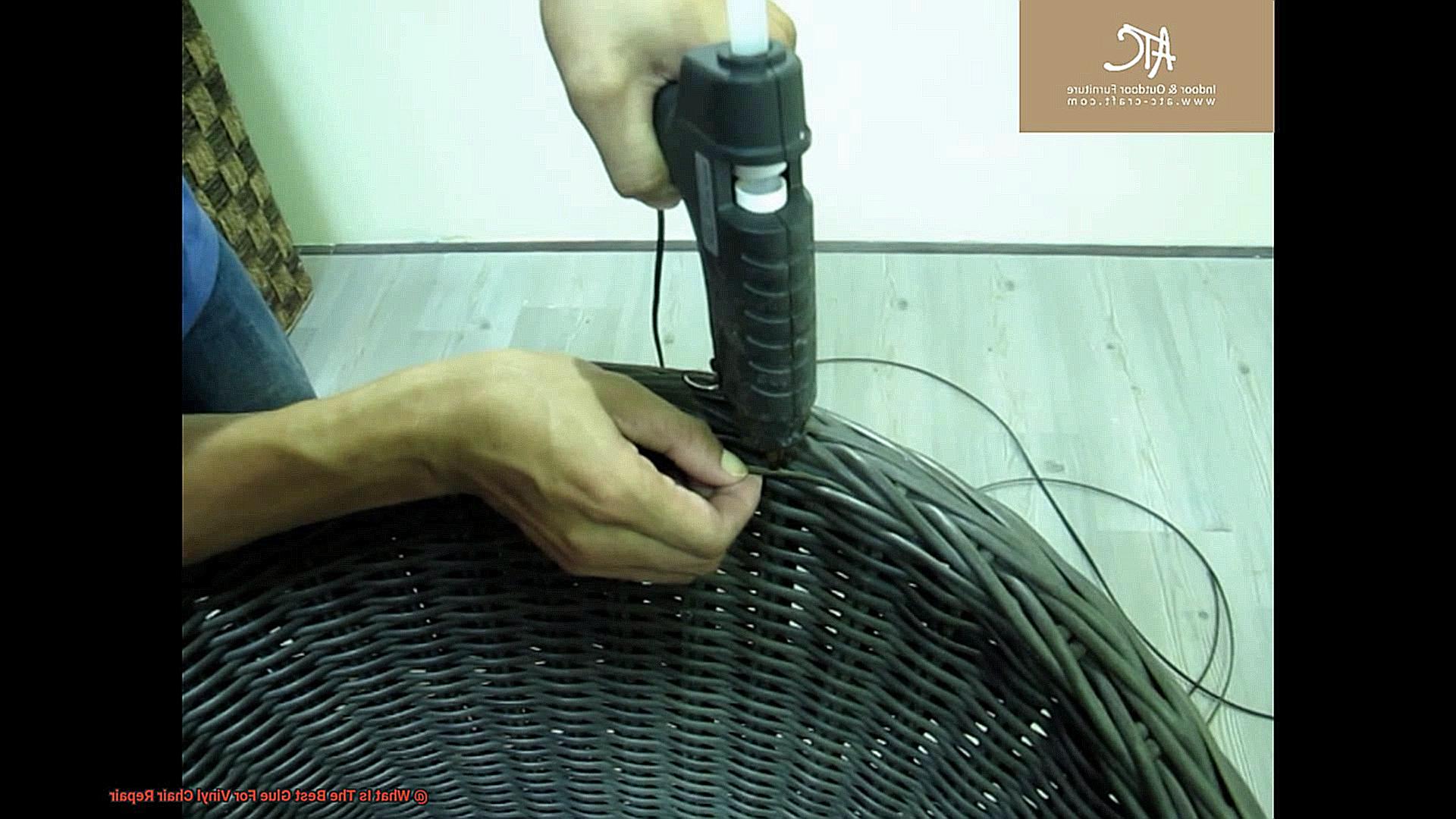
Applying vinyl cement adhesives is a breeze. Just follow the manufacturer’s instructions: apply the adhesive to both surfaces, press them firmly together, and allow sufficient drying time for the bond to fully form. It’s as simple as 1-2-3. No advanced DIY skills required.
Contact Adhesives
Vinyl chairs add a touch of style to any space, but as time goes by, wear and tear can diminish their beauty. Loose seams, tears, and separations can turn your beloved chair into an unsightly mess. But fear not. A hero exists in the realm of chair repair, and it goes by the name of Contact Adhesive. Join us as we explore the incredible features and benefits of these adhesives specially designed for vinyl chair repair.
Versatility:
Contact adhesives are the chameleons of the adhesive world, capable of bonding with a wide range of materials. From vinyl to fabric, leather to wood, contact adhesives have got you covered. So whether you’re repairing a vinyl chair or fixing other furniture pieces, rest assured that contact adhesives will rise to the challenge.
Forms:
Contact adhesives come in various forms, offering flexibility for different repair needs. Liquid adhesives can be easily applied using a brush or roller, guaranteeing an even coating for seamless repairs. Spray adhesives provide unrivaled convenience and effortless application. For those who seek precision, gel adhesives offer better control during application, ensuring perfect results every time.
Strong Bonding:
Contact adhesives create a bond that rivals your favorite Netflix series in durability. The process is simple yet powerful: apply a thin layer of adhesive to both surfaces, allow it to dry for the specified time, and then firmly press them together. Voila. A strong bond is formed that can withstand even the wildest chair movements.
Heat Resistance:
Imagine this: you’re basking in the warm glow of a sunny day on your newly repaired vinyl chair. The temperature rises, but your chair remains intact, thanks to contact adhesives’ excellent heat resistance. These remarkable adhesives can withstand high temperatures without compromising their bonding strength, ensuring the longevity of your repaired chair.
Considerations:
It’s important to note that contact adhesives may have a strong odor during application and drying. To ensure a safe and comfortable experience, it’s best to use them in a well-ventilated area or wear a mask if necessary. Remember, safety first.
Choosing a Water-Resistant or Waterproof Glue
Vinyl chairs, with their durability and low maintenance, are a popular choice for both indoor and outdoor use. However, over time, these chairs may start to show signs of wear and tear, such as cracks or tears in the vinyl material. Luckily, there is a solution: water-resistant or waterproof glue.
Choosing the right glue for your vinyl chair repair requires careful consideration. The first step is to determine the level of water resistance needed for your specific project. If your chairs are primarily used indoors and are not exposed to excessive moisture or water spills, a water-resistant glue may be sufficient. However, if your chairs are frequently used outdoors or in areas where they may come into contact with water, a waterproof glue is a must.
There are several types of glues available for vinyl chair repair, each with its own unique pros and cons. Let’s take a closer look at some popular options:
- Epoxy adhesive: Known for its excellent water resistance and bonding strength, epoxy adhesives consist of two parts – a resin and a hardener – that must be mixed together before use. Once applied, epoxy adhesives create a strong bond that is resistant to water and other environmental factors. They are suitable for both indoor and outdoor applications.
- Polyurethane glue: Also known as PU glue, polyurethane glues form a strong bond that is resistant to water, heat, and chemicals. They have good flexibility, making them suitable for repairs on flexible vinyl materials.
- Contact adhesive: Particularly useful for repairing large areas or joining different pieces of vinyl together, certain types of contact adhesives are water-resistant or waterproof. They provide a strong bond between surfaces but require careful adherence to the manufacturer’s instructions for application and drying time.
When choosing a water-resistant or waterproof glue for your vinyl chair repair, be sure to read the product labels and specifications. Look for glues that specifically mention their resistance to water or have a waterproof claim. Additionally, consider any additional features or qualities that may be important for your specific project, such as flexibility, drying time, or ease of application.
Choosing a Glue That Dries Clear or Matches the Color of the Vinyl Material
Repairing your vinyl chair can be a lifesaver. Whether it’s a favorite chair that you’re attached to or one with sentimental value, choosing the right glue for your vinyl chair repair is crucial for a successful outcome. One important consideration is whether the glue dries clear or matches the color of the vinyl material.
Let’s start with glues that dry clear. These little wonders provide an invisible bond that seamlessly blends with the surrounding vinyl. No one will even know your chair had a tear. Super glue, also known as cyanoacrylate adhesive, is a popular choice. It dries quickly and forms a strong bond. Just make sure you pick one designed specifically for use on vinyl materials to ensure proper adhesion.
On the other hand, if your chair has colored or patterned vinyl upholstery, you might want to consider using an adhesive that matches the color of your chair. These specialized glues come in a range of colors, giving you the power to make that repair practically disappear. They’re usually solvent-based, providing excellent bonding strength while remaining flexible to withstand regular use.
But before you dive into gluing, there are a few things you should know. First, clean and prepare the surface of your chair properly by removing any dirt or grease that could hinder adhesion. Use a mild detergent or rubbing alcohol to get rid of those pesky particles.
Next, test the glue on a small, inconspicuous area of your chair to ensure compatibility and check if it dries clear or matches the color. You don’t want any unpleasant surprises.
When applying the glue, follow the manufacturer’s instructions carefully. Apply a thin and even layer to both surfaces and press them together firmly. Use clamps or heavy objects to hold everything in place while it sets.
After the glue has dried, inspect the repaired area for any visible marks or rough edges. If needed, gently buff away any excess glue using a soft cloth or sandpaper.
Remember, while it’s essential to choose a glue that dries clear or matches the color of your vinyl material for aesthetic purposes, don’t forget about strength and durability. You want a glue that can withstand regular use without compromising the integrity of your chair.
Following Instructions and Application Techniques for Optimal Results
Are you ready to embark on the journey of restoring your beloved vinyl chairs? Well, you’ve come to the right place. Today, we’re going to explore the concept of following instructions and applying techniques that will leave your chairs looking as good as new. So, let’s dive in.
- Surface Preparation: Before reaching for that glue, proper surface preparation is key. Imagine trying to stick two pieces of paper together when one is covered in dirt and grease – not a pretty sight, right? The same applies to vinyl chair repair. Clean the surface with a mild detergent or soap and warm water, removing any dust, dirt, or grease. Ensure it’s dry as a bone before moving forward.
- Glue Application: Now comes the fun part – applying the glue. But don’t go overboard. Start with a small amount and spread it evenly on both surfaces that need to be bonded. You can use a brush, sponge, or even a toothpick if you’re feeling fancy. Remember, less is more in this case. Applying too much glue can lead to excess seepage or an unsightly mess.
- Bonding: Once the glue is applied, bring those surfaces together and create some magic. Press them firmly. This will help create a strong bond. Hold them together for a few minutes to allow the glue to set properly. Some glues may require clamping or using weights – so don’t forget to check those instructions.
- Patience: Now here’s the hard part – patience. Give that glue some time to cure. Different glues have different curing times, so read the instructions and play by the rules. During this crucial period, avoid putting any stress or strain on the repaired area. You don’t want to jeopardize that bond you worked so hard to create.
- Choosing the Right Glue: To achieve optimal results, it’s essential to choose a glue specifically designed for vinyl chair repair. This ensures compatibility and maximum effectiveness. Take good care of your glue. Store it in a cool and dry place to maintain its quality and extend its shelf life.
DHsuFwA9pcM” >
Also Read: Does Gorilla Glue Work On Fabric?
Conclusion
In conclusion, the quest for the best glue to repair your worn-out vinyl chairs is of utmost importance. It’s the key to breathing new life into these tired seats. Whether you opt for vinyl cement adhesives or contact adhesives, there are several crucial factors to consider.
First and foremost, adhesive strength and flexibility are paramount. You need a glue that can handle the stress and movement endured by vinyl chairs without flinching. And let’s not forget about water resistance – a must-have feature if your chairs will face moisture or outdoor conditions. Additionally, take note of drying time, ease of application, and color-matching capabilities for an aesthetically pleasing repair job.
Vinyl cement adhesives are specifically formulated to bond vinyl materials with unwavering permanence. They effortlessly create connections that withstand movements without cracking or breaking – flexible and durable as ever. The application process is a breeze, ensuring a strong hold every time.
On the other hand, contact adhesives offer versatility and formidable bonding capabilities across various materials, including vinyl. With liquid, spray, or gel options at your disposal, precise application becomes second nature – convenience at its finest.
When it comes to water resistance or waterproofing needs, assess the level of moisture exposure your chairs will endure. Look no further than epoxy adhesive, polyurethane glue, or select types of contact adhesives for excellent protection against H2O infiltration.
Lastly but certainly not leastly (yes, we made up that word), follow instructions diligently and employ proper techniques during the repair process for optimal results. Don’t skimp on surface preparation – it sets the foundation for success. Apply glue evenly and firmly; be patient during curing time; choose a glue specifically designed for repairing vinyl chairs – all these steps ensure a triumphant restoration of your beloved seating companions.
So don’t let those tears or loose seams get you down. Armed with the right glue and a dash of tender loving care, your vinyl chairs can once again bask in the limelight.


